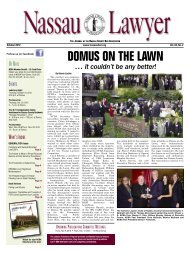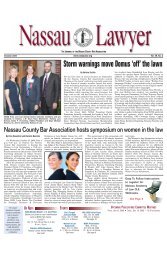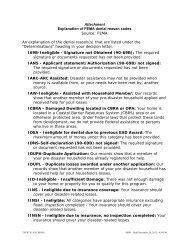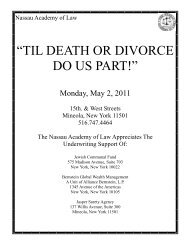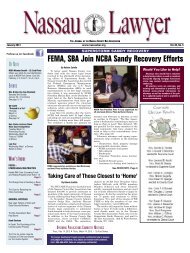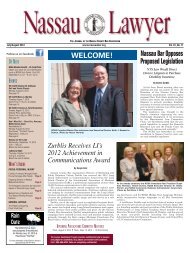Page 3257 A.D.2d 526, 684 N.Y.S.2d 244, 1999 N.Y. Slip Op. 00749(Cite as: 257 A.D.2d 526, 684 N.Y.S.2d 244)Due to the difficulty <strong>of</strong> proving actual intent to hinder,delay, or defraud creditors, the creditor in afraudulent conveyance action under Debtor andCreditor <strong>Law</strong> is allowed to rely on “badges <strong>of</strong> fraud”to support his claim for actual fraud, i.e., circumstancesso commonly associated with fraudulenttransfers that their presence gives rise to an inference<strong>of</strong> intent. McKinney's Debtor and Creditor <strong>Law</strong> §276.[8] Fraudulent Conveyances 186 14186 Fraudulent Conveyances186I Transfers and Transactions Invalid186I(A) Grounds <strong>of</strong> Invalidity in General186k13 Badges <strong>of</strong> Fraud186k14 k. In General. Most Cited CasesFactors that are considered “badges <strong>of</strong> fraud” forpurposes <strong>of</strong> claim for actual fraud under fraudulentconveyance provisions <strong>of</strong> Debtor and Creditor <strong>Law</strong>are: (1) a close relationship between parties to allegedfraudulent transaction; (2) a questionable transfer notin the usual course <strong>of</strong> business; (3) inadequacy <strong>of</strong>consideration; (4) transferor‘s knowledge <strong>of</strong> creditor'sclaim and the inability to pay it; and (5) retention <strong>of</strong>control <strong>of</strong> property by transferor after conveyance.McKinney's Debtor and Creditor <strong>Law</strong> § 276.[9] Limitation <strong>of</strong> Actions 241 99(2)241 Limitation <strong>of</strong> Actions241II Computation <strong>of</strong> Period <strong>of</strong> Limitation241II(F) Ignorance, Mistake, Trust, Fraud,and Concealment or Discovery <strong>of</strong> Cause <strong>of</strong> Action241k98 Fraud as Ground for Relief241k99 In General241k99(2) k. Fraud in the Purchase,Sale, or Acquisition <strong>of</strong> Property. Most Cited CasesA claim for constructive fraud under fraudulent conveyanceprovisions <strong>of</strong> Debtor and Creditor <strong>Law</strong> accruesat the time the fraud or conveyance occurs.McKinney's Debtor and Creditor <strong>Law</strong> §§ 270, 273;McKinney's CPLR 213, subd. 1.[10] Fraudulent Conveyances 186 248186 Fraudulent Conveyances186III Remedies <strong>of</strong> Creditors and Purchasers186III(F) Time to Sue186k248 k. Time to Sue and Limitations.Most Cited CasesLimitation <strong>of</strong> Actions 241 99(2)241 Limitation <strong>of</strong> Actions241II Computation <strong>of</strong> Period <strong>of</strong> Limitation241II(F) Ignorance, Mistake, Trust, Fraud,and Concealment or Discovery <strong>of</strong> Cause <strong>of</strong> Action241k98 Fraud as Ground for Relief241k99 In General241k99(2) k. Fraud in the Purchase,Sale, or Acquisition <strong>of</strong> Property. Most Cited CasesLimitation <strong>of</strong> Actions 241 100(3)241 Limitation <strong>of</strong> Actions241II Computation <strong>of</strong> Period <strong>of</strong> Limitation241II(F) Ignorance, Mistake, Trust, Fraud,and Concealment or Discovery <strong>of</strong> Cause <strong>of</strong> Action241k98 Fraud as Ground for Relief241k100 Discovery <strong>of</strong> Fraud241k100(3) k. Fraud in ObtainingPossession <strong>of</strong> or Title to Property. Most Cited CasesClaim for actual fraud under fraudulent conveyanceprovisions <strong>of</strong> the Debtor and Creditor <strong>Law</strong> is timelyif brought either within six years <strong>of</strong> the date that thefraud or conveyance occurs or within two years <strong>of</strong> thedate that the fraud or conveyance is discovered orshould have been discovered, whichever is longer.McKinney's Debtor and Creditor <strong>Law</strong> § 276;McKinney's CPLR 203(g).**246 Joseph S. Rosenthal, for Plaintiff-Appellant.Richard L. Spinogatti, for Defendants-Respondents.ROSENBERGER, J.P., WILLIAMS, ANDRIAS andSAXE, JJ.MEMORANDUM DECISION.*526 Judgment, Supreme Court, New York County(Edward Lehner, J.), entered May 12, 1997, which,upon defendants' CPLR 3211(a)(7) motion, dismissedplaintiff's second amended legal malpractice complaint,unanimously reversed, on the law, with costs,and plaintiff granted leave to file and serve the thirdamended complaint. Appeal from order, same courtand Justice entered May 6, 1997, unanimously dismissedas subsumed within the appeal from thejudgment. Appeal from order, same court and Justice,© 2009 Thomson Reuters. No Claim to Orig. US Gov. Works.
Page 4257 A.D.2d 526, 684 N.Y.S.2d 244, 1999 N.Y. Slip Op. 00749(Cite as: 257 A.D.2d 526, 684 N.Y.S.2d 244)entered November 17, 1997, which denied plaintiff'smotion deemed to be one for reargument, unanimouslydismissed, without costs, as taken from anon-appealable order.[1][2] In the context <strong>of</strong> a CPLR 3211 motion to dismiss,where we must take the factual allegations <strong>of</strong>the complaint as true, consider the affidavits submittedon the motion only for the limited purpose <strong>of</strong> determiningwhether the plaintiff has stated a claim, notwhether he has one and, in the absence <strong>of</strong> pro<strong>of</strong> *527that an alleged material fact is untrue or beyond significantdispute, must not dismiss the complaint(Guggenheimer v. Ginzburg, 43 N.Y.2d 268, 275,401 N.Y.S.2d 182, 372 N.E.2d 17; Rovello v. Or<strong>of</strong>inoRealty Co., 40 N.Y.2d 633, 634-36, 389 N.Y.S.2d314, 357 N.E.2d 970), we find that plaintiff's allegationsare sufficient to support its contentions that itsfraudulent conveyance claims were viable and potentiallysuccessful when brought to defendants' attentionin 1986, that as a consequence, its claims forlegal malpractice and breach <strong>of</strong> contract to performlegal services were sufficiently alleged, and that themotion court erred in granting dismissal <strong>of</strong> the complaint.We also grant leave to amend the complaint,notwithstanding the motion court's denial <strong>of</strong> plaintiff'smotion for reargument, where plaintiff had previouslysought, and the court failed to address, suchrelief in its opposition to defendants' motion to dismiss,and where the proposed third amended complaintclearly sets forth an adequate basis for plaintiff'sclaims. It is well-settled that leave to amendshould be freely granted (Dittmar Explosives v. A.E.Ottaviano, 20 N.Y.2d 498, 502, 285 N.Y.S.2d 55,231 N.E.2d 756; Lambert v. Williams, 218 A.D.2d618, 621, 631 N.Y.S.2d 31), and that strong publicpolicy favors resolving cases on the merits (see,Amer. Continental Properties v. Natl. Union Fire Ins.Co., 200 A.D.2d 443, 446, 608 N.Y.S.2d 807; Segallv. Heyer, 161 A.D.2d 471, 473, 555 N.Y.S.2d 738).Plaintiff alleged in its legal malpractice action thatdefendants successfully obtained for it a $6.1 millionjudgment in the underlying arbitration proceedingagainst, inter alia, its former general managing partners,Michael Wise and Monroe Friedman, for fraud,conversion, breach <strong>of</strong> fiduciary duty and negligence,but failed to bring an action against them, pursuant tothe Debtor and Creditor <strong>Law</strong>, to set aside allegedfraudulent conveyances to their spouses <strong>of</strong> their respective25% ownership interests in Enseco, Inc..Plaintiff further alleged that these conveyances renderedWise and Friedman judgment-pro<strong>of</strong>, **247 andresulted in plaintiff's recovery <strong>of</strong> only $500,000.[3][4] The plaintiff in a legal malpractice action mustestablish that the attorney in question was negligent,that the attorney's negligence was the proximatecause <strong>of</strong> the loss sustained, and that actual damageswere sustained. It must be established that “but for”the attorney's negligence, the underlying actionwould have succeeded (Greenwich v. Markh<strong>of</strong>f, 234A.D.2d 112, 114, 650 N.Y.S.2d 704; Lauer v. Rapp,190 A.D.2d 778, 593 N.Y.S.2d 843). In addition, inorder to establish the proximate cause and actualdamages elements, plaintiff must show that the Statute<strong>of</strong> Limitations on the underlying claim had run bythe time that it discharged defendants as its attorneys(see, C & F Pollution Control v. Fidelity and CasualtyCo. <strong>of</strong> New York, 222 A.D.2d 828, 829, 653N.Y.S.2d 704).[5] *528 With regard to plaintiff's DCL § 273 claim,for example, it had to establish that the debtors madea conveyance, that they were insolvent prior to theconveyance or rendered insolvent thereby, and thatthe conveyance was made without fair consideration(United States v. McCombs, 30 F.3d 310, 323; UnitedStates v. Carlin, 948 F.Supp. 271, 277). The motioncourt, in dismissing the second amended complaint,found that plaintiff failed to plead the existence <strong>of</strong> aconveyance and did not allege the insolvency element.However, DCL § 270 defines “conveyance”broadly and it has been held that the term includes aprospective debtor's arrangement to have stock issuedin the name <strong>of</strong> his wife (see, Levy v. Braverman, 24A.D.2d 430, 260 N.Y.S.2d 681). Applying this definitionto the instant matter, where the complaint citesFriedman's arbitration testimony that his Ensecostock was placed in his wife's name to insulate itfrom anticipated judgment creditors, it is clear thatthe complaint adequately alleges that a conveyanceoccurred. The insolvency element can be sufficientlymade out from the complaint in that it alleges thatWise and Friedman were judgment-pro<strong>of</strong> when plaintiffattempted to enforce its judgment (see, UnionNatl. Bank v. Russo, 64 A.D.2d 759, 760, 406N.Y.S.2d 930). Finally, triable issues <strong>of</strong> fact wereraised as to the fairness <strong>of</strong> the consideration paid forthe conveyance, since the spouses' purchase <strong>of</strong> theshares at such a favorable price here appears to bedubious. Fairness <strong>of</strong> the consideration is a question <strong>of</strong>© 2009 Thomson Reuters. No Claim to Orig. US Gov. Works.
- Page 1 and 2:
Nassau Academy of LawCLE Live Class
- Page 3 and 4:
McKinney's Debtor and Creditor Law
- Page 5 and 6:
McKinney's Debtor and Creditor Law
- Page 7 and 8:
McKinney's Debtor and Creditor Law
- Page 9 and 10:
McKinney's Debtor and Creditor Law
- Page 11 and 12:
McKinney's Debtor and Creditor Law
- Page 13 and 14:
McKinney's Debtor and Creditor Law
- Page 15 and 16:
McKinney's Debtor and Creditor Law
- Page 17 and 18:
McKinney's Debtor and Creditor Law
- Page 19 and 20:
BAKER & HOSTETLER LLP45 Rockefeller
- Page 21 and 22:
usiness of defendant Bernard L. Mad
- Page 23 and 24:
BACKGROUND, THE TRUSTEE, AND STANDI
- Page 25 and 26:
Madoff who received fraudulent tran
- Page 27 and 28:
ased on fictitious profits and for
- Page 29 and 30:
28. BLMIS funds were also used to p
- Page 31 and 32:
Madoff, and her niece, Shana Madoff
- Page 33 and 34:
42. Ruth Madoff was never an employ
- Page 35 and 36:
FIRST CAUSE OF ACTIONTURNOVER AND A
- Page 37 and 38:
66. At the time of each of the Two-
- Page 39 and 40:
Transfers; (b) directing that the S
- Page 41 and 42:
EIGHTH CAUSE OF ACTIONUNDISCOVERED
- Page 43 and 44:
TENTH CAUSE OF ACTIONDISALLOWANCE O
- Page 45 and 46:
111. Mrs. Madoff benefited from the
- Page 47 and 48:
WHEREFORE, the Trustee respectfully
- Page 49 and 50:
2(c)(3): (a) preserving the Subsequ
- Page 51 and 52:
302 B.R. 760 Page 1302 B.R. 760(Cit
- Page 53 and 54:
302 B.R. 760 Page 3302 B.R. 760(Cit
- Page 55 and 56:
302 B.R. 760 Page 5302 B.R. 760(Cit
- Page 57 and 58:
302 B.R. 760 Page 7302 B.R. 760(Cit
- Page 59 and 60:
302 B.R. 760 Page 9302 B.R. 760(Cit
- Page 61 and 62:
302 B.R. 760 Page 11302 B.R. 760(Ci
- Page 63 and 64:
302 B.R. 760 Page 13302 B.R. 760(Ci
- Page 65 and 66:
302 B.R. 760 Page 15302 B.R. 760(Ci
- Page 67 and 68:
302 B.R. 760 Page 17302 B.R. 760(Ci
- Page 69 and 70: 302 B.R. 760 Page 19302 B.R. 760(Ci
- Page 71 and 72: 394 B.R. 721 Page 1394 B.R. 721, 50
- Page 73 and 74: 394 B.R. 721 Page 3394 B.R. 721, 50
- Page 75 and 76: 394 B.R. 721 Page 5394 B.R. 721, 50
- Page 77 and 78: 394 B.R. 721 Page 7394 B.R. 721, 50
- Page 79 and 80: 394 B.R. 721 Page 9394 B.R. 721, 50
- Page 81 and 82: 394 B.R. 721 Page 11394 B.R. 721, 5
- Page 83 and 84: 394 B.R. 721 Page 13394 B.R. 721, 5
- Page 85 and 86: 394 B.R. 721 Page 15394 B.R. 721, 5
- Page 87 and 88: 394 B.R. 721 Page 17394 B.R. 721, 5
- Page 89 and 90: 394 B.R. 721 Page 19394 B.R. 721, 5
- Page 91 and 92: 394 B.R. 721 Page 21394 B.R. 721, 5
- Page 93 and 94: 397 B.R. 642 Page 2397 B.R. 642(Cit
- Page 95 and 96: 397 B.R. 642 Page 4397 B.R. 642(Cit
- Page 97 and 98: 397 B.R. 642 Page 6397 B.R. 642(Cit
- Page 99 and 100: 397 B.R. 642 Page 8397 B.R. 642(Cit
- Page 101 and 102: 397 B.R. 642 Page 10397 B.R. 642(Ci
- Page 103 and 104: 397 B.R. 642 Page 12397 B.R. 642(Ci
- Page 105 and 106: 397 B.R. 642 Page 14397 B.R. 642(Ci
- Page 107 and 108: 443 F.3d 180 Page 2443 F.3d 180(Cit
- Page 109 and 110: 443 F.3d 180 Page 4443 F.3d 180(Cit
- Page 111 and 112: 443 F.3d 180 Page 6443 F.3d 180(Cit
- Page 113 and 114: 443 F.3d 180 Page 8443 F.3d 180(Cit
- Page 115 and 116: 443 F.3d 180 Page 10443 F.3d 180(Ci
- Page 117 and 118: 443 F.3d 180 Page 12443 F.3d 180(Ci
- Page 119: Page 2257 A.D.2d 526, 684 N.Y.S.2d
- Page 123 and 124: Page 6257 A.D.2d 526, 684 N.Y.S.2d
- Page 125 and 126: 770 N.Y.S.2d 421 Page 22 A.D.3d 780
- Page 127 and 128: Page 14 A.D.3d 495, 773 N.Y.S.2d 71
- Page 129: Page 34 A.D.3d 495, 773 N.Y.S.2d 71
- Page 132 and 133: 780 N.Y.S.2d 409 Page 29 A.D.3d 553
- Page 134 and 135: Page 134 A.D.3d 231, 824 N.Y.S.2d 3
- Page 136 and 137: Page 334 A.D.3d 231, 824 N.Y.S.2d 3
- Page 138 and 139: Page 2991 F.2d 31(Cite as: 991 F.2d
- Page 140 and 141: Page 4991 F.2d 31(Cite as: 991 F.2d
- Page 142 and 143: Page 6991 F.2d 31(Cite as: 991 F.2d
- Page 144 and 145: FRAUDULENT TRANFERENCESRonald M. Te
- Page 146 and 147: Nursing home case_ Transfer of pers
- Page 148 and 149: Sections 548 and 544 work in concer
- Page 150 and 151: U.S. Supreme CourtBFP v. Resolution
- Page 152 and 153: example, from net 15 to COD; or cha
- Page 154 and 155: Bankruptcy Code Section§ 548. Frau
- Page 156: Ron Terenzi is a founding partner a



